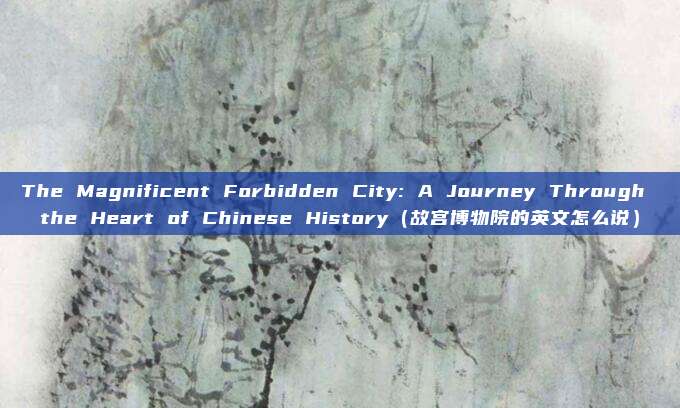The Magnificent Forbidden City: A Journey Through the Heart of Chinese History(故宫博物院的英文怎么说)
温馨提示:这篇文章已超过247天没有更新,请注意相关的内容是否还可用!
Introduction:
Nestled in the heart of Beijing, the Forbidden City stands as a testament to China's rich history and architectural prowess. Known in English as the "Imperial Palace Museum," this ancient complex has been a symbol of power and grandeur for centuries. In this article, we delve into the fascinating history, architectural wonders, and cultural significance of the Forbidden City, exploring why it remains a must-visit destination for anyone interested in the heart of Chinese heritage.
The Rich History of the Forbidden City
The Forbidden City, officially known as the "Imperial Palace Museum," was the imperial palace of the Ming and Qing dynasties. Constructed in 1406 and completed in 1420, it served as the imperial residence for 24 emperors over a period of nearly 500 years. The name "Forbidden City" is derived from the fact that it was off-limits to the general public, a status that persisted until the establishment of the People's Republic of China in 1949.

Covering an area of over 720,000 square meters and housing over 8,700 rooms, the Forbidden City is not only the largest palace complex in the world but also a treasure trove of historical artifacts. It was designated a UNESCO World Heritage Site in 1987, recognizing its cultural and historical importance.
Architectural Marvels of the Forbidden City
The architecture of the Forbidden City is a marvel of ancient Chinese design. The complex is divided into two main parts: the Outer Court and the Inner Court. The Outer Court, the northern part of the complex, was used for state ceremonies and was the site of the emperor's audience halls and throne rooms. The Inner Court, to the south, was the private living quarters of the emperor and his family.
One of the most iconic structures within the Forbidden City is the Hall of Supreme Harmony, the largest and most magnificent building in the complex. It was the main hall where emperors conducted state affairs and performed rituals. The Hall of Central Harmony and the Hall of Preserving Harmony are also prominent structures within the Outer Court.
The Forbidden City is renowned for its intricate roof designs, each symbolizing different aspects of Chinese culture and governance. The use of glazed tiles with intricate patterns and colors is a testament to the skill of ancient Chinese artisans.
Cultural Significance and Artifacts
The Forbidden City is a repository of thousands of years of Chinese culture and history. The museum houses an extensive collection of artifacts, including pottery, paintings, calligraphy, and bronze objects. These artifacts not only provide insights into the lives of the emperors but also offer a glimpse into the daily life of ancient China.
The collection includes items from the Neolithic period to the late Qing Dynasty, making it a comprehensive representation of Chinese history. Some of the most significant artifacts include the "Qingming Shangshan," a scroll painting by Zhang Zeduan, and the "Heavenly Empress of Jade," a life-sized jade figure.
Visiting the Forbidden City
Today, the Forbidden City is open to the public, welcoming millions of visitors each year. To ensure a pleasant visit, it is advisable to purchase tickets in advance, as the complex can be crowded, especially during peak tourist seasons.
The Forbidden City is not just a historical site; it is an experience. Visitors can walk through the vast courtyards, admire the ancient architecture, and imagine the grandeur of imperial life. The intricate details of the buildings, the beautiful gardens, and the serene atmosphere make it a truly unforgettable destination.
Conclusion:
The Forbidden City, or the Imperial Palace Museum in English, is more than just a historical site; it is a living testament to the depth and complexity of Chinese history and culture. Its architectural wonders, cultural artifacts, and rich history make it a must-visit destination for anyone traveling to Beijing. Whether you are a history buff or simply curious about the past, the Forbidden City offers a journey through time that is both educational and profoundly moving.
网站文章、图片来源于网络,以不营利的目的分享经验知识,版权归原作者所有。如有侵权请联系删除!





还没有评论,来说两句吧...